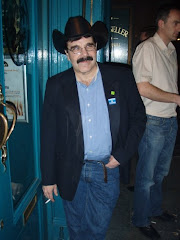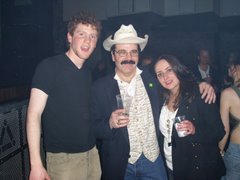Republican Politics, American Style
Published May 10th in Metro Eireann By Charles Laffiteau
US Ambassador Thomas Foley began his talk at Dublin City University (DCU) by telling the audience what he hoped to accomplish with this appearance. He started out by trying to frame the issue in terms of where the US stood relative to other countries in Europe as regards energy consumption and reducing carbon emissions as suggested in the Kyoto Protocol.
The Ambassador was on pretty firm ground here and some of the facts he referenced may have come as a surprise to some audience members. He got the bad news out of the way early by acknowledging that the US was indeed the world’s biggest polluter in terms of generating green house gases. He duly noted statistics which for example show that on a per person basis, the US generated more than 2 times as much carbon based wastes as the average German, 3 times more than the French and 40% more than the average Irish resident. From this point on, the Ambassador moved into a defensive justification or attack mode.
He said that while the US was the largest polluter in terms of total carbon wastes generated by a single country, it would be overtaken this year by China. While I think this comment was a bit of a stretch since this won’t actually happen until 2009, I will nonetheless concede this point. But the Ambassador also failed to mention that China has over one billion more citizens than the US, which means the Chinese will still only be generating 25% of the carbon wastes that are generated by the average American once it does become the world’s biggest polluting nation.
Ambassador Foley then went on to defend the US decision not to sign the Kyoto Protocol because it assigned mandatory emission limits for the reduction of greenhouse gas emissions to each signatory nation. He said that the 30% cuts in carbon emissions demanded of the US would have caused serious economic problems had the US agreed to these limitations. Mr. Foley then noted that Australia, which like the US relies on coal to generate much of its electricity, had also declined to sign the Kyoto Protocol. Ambassador Foley went on to say that the US wanted to ensure that carbon gas emission limits were also applied to countries such as China, which is not required to cut emissions under the current treaty. I must agree with him on this issue.
The Ambassador then pointed out that even though the US had not agreed to the limits, it had nonetheless done a better job of cutting the rate of growth in its carbon gas emissions than the EU countries which had signed the Kyoto Protocol. It may have come as a bit of a surprise to some in the audience that the US had cut this rate of growth to a level that was 40% less than the the EU average. But he also failed to mention that it is much easier to cut one’s rate of growth when you are already generating wastes at a much higher level than nations you are comparing yourself to.
President Bush’s strategy to tackle global warming basically relies on scientific developments and voluntary measures, rather than curbs on greenhouse-gas emissions.As part of his sales pitch to pesuade the audience that the Bush administration is seriously doing something to address the problem of global warming, Ambassador Foley outlined three methods being used to cut US green house gas emissions followed by an assessment of each method’s impact
First he mentioned greater energy efficiency being derived from the use of low wattage flourescent light bulbs and better home insulation. He then noted that even if this method was broadly utilized it would, at best, result in a 20-30% increase in energy efficiency which would be equivalent to the growth of energy consumption.
Secondly, he referred to the use of alternative sources of energy such as wind, hydro, solar and nuclear. He mentioned France as a country which emits less green house gases per person, largely because it derives 70% of its electricity from nuclear energy. The Ambassador then stated that while the US obtains about 18% of its electricity from such sources currently, their contribution was likely to drop in the near future due to the long lead times involved in bringing these types of power generation on line. In fact it has been almost thirty years since the US ordered its last nuclear plant, due to the US public’s fears about nuclear accidents after the near meltdown at Three Mile Island and the subsequent release of the anti-nuclear plant movie “The China Syndrome”.
Finally, the Ambassador alluded to the recapture of carbon emissions and sequestration of green house gases through the use of rapid reforestration, which involves planting new forests of trees on land which is no longer being used for agriculture. The impact of this program is hard to quantify, but suffice to say it is not going to result in major reductions in green house gas emissions.
By outlining all of the available “voluntary” measures for reducing green house gas emissions, Ambassador Foley had thus set the stage for what President Bush touts as the ultimate solution, new technologies. The Ambassador cited the need for technological breakthroughs in the development of fuel cells and nuclear fusion as sources of clean energy which could then be used to replace carbon based energy sources. But to realize this goal entails continuing to grow economically so that money can be generated to invest in these new technology solutions.
Noticeably absent from Ambassador Foley’s discussion of President Bush’s proposals to reduce green house gases are federal government regulations to increase automobile fuel economy standards and reduce carbon dioxide emissions. The Ambassador noted that individual states like California had always led the way in this area and that the US government would follow once a consensus had emerged at the state level. However, as I mentioned in my previous column, the US Supreme Court recently chastized Bush appointees at the EPA for refusing to regulate automobile emissions of green house gases as mandated by existing federal laws.
Nor was any mention made of a separate and unanimous Supreme Court ruling which said that the EPA also had authority over factories and power plants that add generating capacity or make renovations that increase emissions of air pollutants. One must therefore conclude that the Bush administration’s refusal to uphold existing federal laws governing green house gas emissions by automobiles and power plants is seriously at odds with the Ambassador’s contention that President Bush is very concerned about this problem and is actively working to address it.
While I believe the US Ambassador was being sincere and honest in discussing what he believes the Bush administration is doing to address climate change, the actions of the Bush administration thus far speak much louder than Ambassador Foley’s words.
Subscribe to:
Post Comments (Atom)



No comments:
Post a Comment